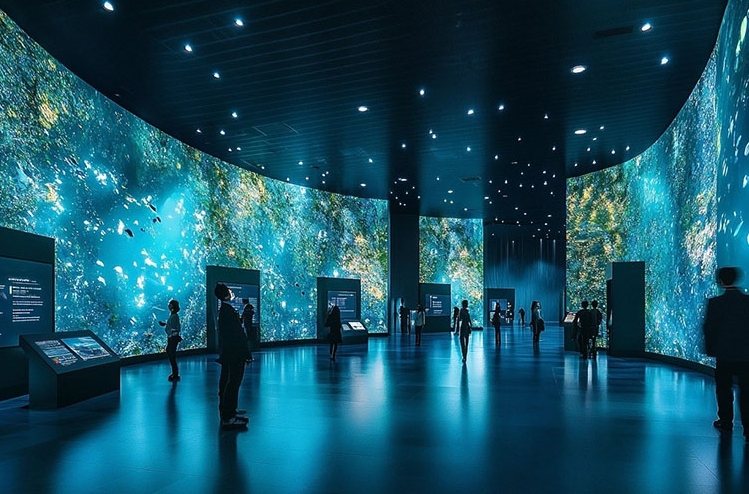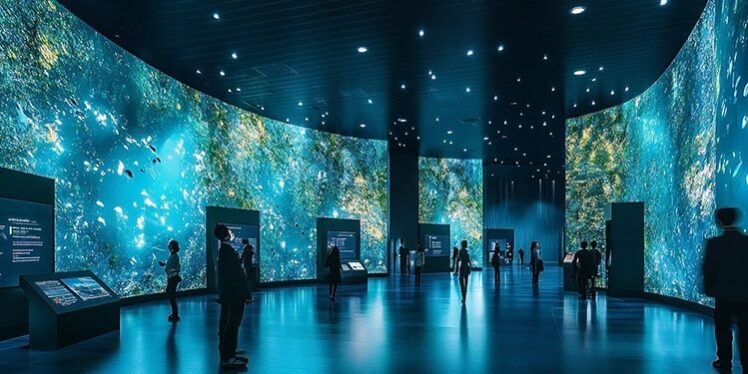In the exhibition design realm, “interactive light walls” are no longer unfamiliar concepts. However, many observers and even some designers still perceive them merely as dynamic, visually appealing “display screens”—unidirectional information broadcasting mediums. This perception significantly underestimates the tremendous interactive potential and value that light walls possess in contemporary exhibition spaces.
These installations are far more than animated static graphics. Through cutting-edge technology, they construct intelligent interfaces filled with perception and feedback capabilities, fundamentally revolutionizing how people connect with spaces and information.

The Limitations of Traditional Exhibition Methods
Traditional exhibition information delivery models frequently encounter the dual predicament of “overload” and “ineffectiveness.” Previously, most exhibitions relied on static display boards, showcase arrangements, or unidirectional screen broadcasts that, while containing substantial content, struggled to effectively capture visitors’ rapidly shifting attention.
Modern Visitor Expectations
Today’s audiences crave far more than simple “viewing” experiences. They demand:
- Deep participation in exhibition content
- Personalized exploration pathways
- Immediate feedback and response systems
- Interactive dialogue with presented information
The Need for Transformation
Exhibition design urgently requires evolution from “information notification” to “experience-driven” approaches. Interactive light walls serve as crucial carriers for this transformation, bridging the gap between passive consumption and active engagement.
Advanced Interactive Design Technologies
An exceptional interactive light wall activates its interactive value through sophisticated technological integration that creates meaningful connections between visitors and content.
Motion Sensing Capabilities
Modern sensor technology enables walls to detect and respond to various types of human movement:
- Proximity sensors triggering content changes as visitors approach
- Gesture recognition interpreting hand movements and body language
- Spatial tracking monitoring visitor positions within the exhibition space
- Multi-user detection accommodating simultaneous interactions
Body-Gesture Interaction: Making the Body an Interface
Motion Capture Triggering
This represents the most intuitive form of interaction. When visitors approach interactive light walls, their physical movements—hand waves, jumps, posture changes—are precisely captured by embedded sensors including infrared, radar, and depth cameras.
Real-time responsiveness creates powerful engagement:
- Virtual particles dancing with hand movements
- Environmental changes triggered by body positioning
- Immersive effects responding to visitor presence
- Dynamic content adapting to movement patterns
Spatial Position Awareness
Advanced interactive light walls not only sense movements but also precisely locate visitors within the space. When visitors approach specific areas, wall content automatically transforms, expanding detailed interpretations or triggering particular scenarios.
Technical Implementation
Sophisticated positioning systems incorporate:
- 3D spatial mapping for accurate location tracking
- Zone-based content triggers activating relevant information
- Crowd flow analysis optimizing content delivery
- Privacy-conscious tracking maintaining visitor anonymity
Touch Interaction: Deep Exploration at Your Fingertips
Multi-Point Touch Operations
Large-scale touchscreen technology combined with projection enables visitors to directly interact with massive wall surfaces using finger gestures including clicking, sliding, scaling, and rotating. This approach particularly suits scenarios requiring deep information excavation.
Practical Applications
Touch-enabled exploration includes:
- Layered corporate technology trees revealing detailed organizational structures
- 3D product model manipulation allowing detailed component examination
- High-resolution historical map navigation with zoom and pan capabilities
- Interactive timeline exploration connecting past and present events
Virtual Buttons and Interfaces
Intuitive virtual interface design on interactive light walls features clear buttons, sliders, and menu systems that guide visitors through selection, quiz participation, voting, or program activation (such as simulation assembly or virtual try-on experiences).
User Experience Benefits
Interface-driven interaction provides:
- Clear logical structure reducing learning curves
- Goal-oriented tasks with measurable outcomes
- Accessibility features accommodating diverse abilities
- Multilingual support for international audiences
Advanced Sensor Technologies
LiDAR Integration
Light Detection and Ranging (LiDAR) technology offers unprecedented precision in visitor tracking and environmental awareness:
- Millimeter-accurate positioning for precise interaction zones
- Real-time 3D mapping of visitor movements
- Multiple simultaneous user tracking without interference
- Enhanced privacy protection through anonymous data processing
Computer Vision Systems
AI-powered visual recognition enables:
- Facial expression analysis adapting content to emotional responses
- Age and demographic estimation for targeted content delivery
- Crowd behavior analysis optimizing exhibition flow
- Safety monitoring ensuring visitor wellbeing
Content Management and Customization
Dynamic Content Systems
Flexible content management allows for:
- Real-time updates without system downtime
- A/B testing of different interaction approaches
- Seasonal content rotation maintaining visitor interest
- Event-specific customization for special exhibitions
Data Analytics Integration
Comprehensive analytics platforms provide insights through:
- Visitor engagement metrics measuring interaction duration and depth
- Popular content identification guiding future development
- User journey mapping optimizing exhibition flow
- ROI measurement demonstrating technology value
Industry Applications and Case Studies
Museum and Cultural Institutions
Interactive light walls transform traditional museum experiences through:
- Historical timeline exploration with immersive period recreations
- Artifact examination with detailed 3D models and annotations
- Educational games reinforcing learning objectives
- Virtual curator experiences providing expert insights
Corporate Showrooms
Business environments leverage interactive walls for:
- Product demonstration with customizable configurations
- Company history presentation through engaging storytelling
- Technical specification exploration with detailed comparisons
- Customer testimonial integration building trust and credibility
Trade Shows and Exhibitions
Commercial applications include:
- Lead generation through interactive surveys and contact collection
- Product configurators allowing custom solution building
- Brand storytelling through immersive narrative experiences
- Competitive differentiation through cutting-edge technology adoption
Future Exhibition Development Trends
In today’s information-saturated environment, audiences increasingly reject passive, force-fed displays. They crave dialogue, participation, and the creation of unique personal experiences. Interactive light walls serve as powerful tools responding to these contemporary demands.
Artificial Intelligence Integration
AI-powered enhancements will enable:
- Personalized content recommendations based on visitor behavior
- Natural language processing for voice-activated interactions
- Predictive analytics anticipating visitor needs
- Emotional intelligence adapting to visitor moods and preferences
Augmented Reality Convergence
AR integration expands possibilities through:
- Mobile device synchronization creating extended experiences
- Virtual object placement in physical spaces
- Social sharing capabilities amplifying exhibition reach
- Remote participation connecting global audiences
Sustainability Considerations
Environmentally conscious design focuses on:
- Energy-efficient display technologies reducing power consumption
- Modular system design enabling component reuse and upgrades
- Sustainable materials in construction and installation
- Lifecycle optimization maximizing equipment longevity
Implementation Best Practices
Planning and Strategy
Successful implementation requires:
- Clear objective definition aligning technology with exhibition goals
- Audience analysis understanding visitor demographics and preferences
- Content strategy development creating engaging, relevant experiences
- Budget allocation balancing technology investment with expected returns
Technical Considerations
Professional installation ensures:
- Proper sensor calibration for accurate interaction detection
- Network infrastructure supporting real-time data processing
- Backup systems maintaining continuous operation
- Regular maintenance schedules preserving optimal performance
Staff Training and Support
Operational success depends on:
- Comprehensive staff education about system capabilities and troubleshooting
- Visitor guidance protocols helping users maximize their experience
- Content update procedures maintaining fresh, relevant information
- Performance monitoring identifying optimization opportunities
Measuring Success and ROI
Quantitative Metrics
Performance indicators include:
- Visitor engagement duration compared to traditional displays
- Interaction completion rates measuring content effectiveness
- Return visitor statistics indicating lasting appeal
- Lead generation and conversion rates for commercial applications
Qualitative Assessment
Experience evaluation encompasses:
- Visitor satisfaction surveys measuring engagement quality
- Educational impact assessment for learning-focused applications
- Brand perception changes in corporate environments
- Social media mentions and user-generated content
Interactive light walls represent far more than upgraded dynamic screens. They are intelligent interfaces capable of perception, analysis, and dialogue—core experience nodes that stimulate exploration, empower creativity, deepen brand recognition, and precisely convey value.
When visitor silhouettes merge with flowing light and shadow, when every touch creates ripple-like feedback, exhibition boundaries dissolve completely. In their place emerges a revolutionary relationship characterized by collaborative creation and emotional resonance, transforming passive observation into active participation and meaningful connection.
Through thoughtful implementation of these advanced technologies, exhibition designers can create transformative experiences that not only inform but inspire, educate, and emotionally engage visitors in ways previously impossible through traditional display methods.







